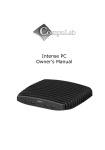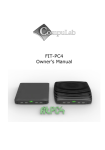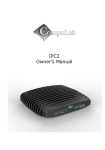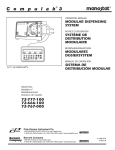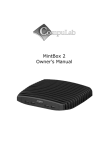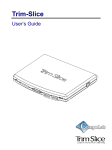Download CompuLab fit-PC2 Owner`s manual
Transcript
fit-PC2i Owner’s Manual fit-PC2i Owner’s Manual 23-Jun-2010 Introduction Package contents Hardware specifications fit-PC2i features Quick start guide Connecting fit-PC2i Booting Linux (applies to fit-PC2i Linux) Booting Windows XP (applies to fit-PC2i XP) Booting Windows 7 (applies to fit-PC2i Win7) Maintenance Affixing rubber feet Installing Hard Disk BIOS Setup Utility BIOS Setup Utility Sections Warranty and RMA Warranty RMA Tips for saving power General In BIOS In Operating System For more information and to obtain the latest revision of this document, please visit www.fit-pc.com 2 Introduction Package contents 1. 2. 3. 4. 5. 6. 7. 8. 9. fit-PC2i computer 12V DC power supply AC cord with North American or localized standard plug HDMI to DVI adapter 3.5mm to RCA cable 2 mini-USB to USB-A adapters Mini serial to DB-9 cable 4 Rubber feet WiFi antenna (in some models) To use fit-PC2, you will need: A display with DVI or HDMI input + DVI or HDMI cable USB keyboard and mouse Hardware specifications Intel Atom Z510/Z530/Z550 * Intel US15W 1GB / 2GB DDR2-533 * 160GB Hard Disk * DVI up to 1920x1200 S/PDIF 5.1 channels Stereo line-out, line-in / mic WiFi 802.11b/g * Ethernet 2x 1000BaseT RJ45 USB 4 ports USB 2.0 Hi-Speed 480Mbps Serial RS232 full UART Power 12V DC __________________ * Depending on model CPU Chipset RAM Storage Display Audio 3 fit-PC2i features USB There are 4 USB ports – 2 USB A ports on the back and 2 mini-USB on the front. All ports support Highspeed USB 2.0 - 480 Mbps. Ports on the back are upside down – note when connecting USB plugs. Serial port The RS232 serial port is placed on the front panel. Use the provided mini-serial to DB9 cable to connect to standard serial devices. DVI Display interface is DVI-D over HDMI connector. To connect fit-PC2i to a DVI display Use the provided HDMI to DVI adapter. Use a DVI cable to connect the adapter to the display. To connect fit-PC2i to a flat-screen TV Use an HDMI cable between the HDMI connector and HDMI input of the TV. Note: Audio should be connected separately. miniSD The miniSD socket supports miniSD cards, including SDIO and SDHC. Audio There are 2 standard 3.5mm jacks on the back. left: S/PDIF using provided cable Stereo line-out Right: Microphone Stereo line-in 4 LAN fit-PC2i has 2 10/100/1000BaseT Ethernet ports using a standard RJ45 connectors. Use a standard Ethernet cable to connect. The connector has built-in LEDs that are lit when a connection is detected. WLAN A WLAN antenna is supplied in models with integrated WiFi and should be screwed into the standard SMA connector. Power button fit-PC2i has a tactile power push-button. It is used for turning on/off the fit-PC and for standby/resume when supported by the operating system. A push of at least 5 seconds will always turn off the fit-PC2i. Note: fit-PC2i supports auto-on. When connected to power it will power-up automatically. LEDs fit-PC2i has 3 indicator LEDs. From left to right – HDD activity WLAN enabled / activity Power Quick start guide Connecting fit-PC2i Turn off the display and connect it to the fit-PC2i HDMI connector (use the HDMI to DVI adapter if needed). Connect the USB keyboard and mouse to USB connectors. Plug the speakers into the line-out jack. Plug the Ethernet cable into the Ethernet connector. In fit-PC2i models with WiFi: Mount the WiFi Antenna on the SMA connector by turning it clockwise repeatedly until the antenna holds firm. Insert the DC plug into the fit-PC2i DC in jack. It is recommended to secure the power plug using the adjacent screw. Connect the power supply to the AC cord and plug the cord into AC outlet. The power LED should light up as the fit-PC2i boots. 5 Booting Linux (applies to fit-PC2i Linux) Ubuntu loads automatically on power up. Login: Username: fit Password: 111111 Booting Windows XP (applies to fit-PC2i XP) Upon first power-up, you will be guided through the Windows Welcome procedure which is selfexplanatory. The Windows XP serial number is printed on the Windows XP label on the bottom of your fit-PC2i. Booting Windows 7 (applies to fit-PC2i Win7) Upon first power-up, you will be guided through the Windows Welcome procedure which is selfexplanatory. The Windows 7 serial number is printed on the Windows 7 label on the bottom of your fitPC2i. Maintenance The fit-PC2i requires no maintenance. You should not take the fit-PC2i apart - this will void its warranty. The following operations can be conducted by the user: Affixing rubber feet You should stick the rubber feet to the bottom of the fit-PC2i to protect the supporting surface. Recommended rubber feet placement is shown below: 6 Installing Hard Disk 1. 2. Open the two HDD screws on the HD door as indicated below and remove it. Release spacers using a 5.5mm nut-driver and remove with attached screw. 3. Slide-in HDD. 7 4. Tighten the four HDD screws indicated below. Removing Hard Disk 1. Open the two HDD screws on base 2. Push out the HDD cover as indicated below. Hard disk will slide out. 8 BIOS Setup Utility Entering BIOS Setup Utility Turn off the fit-PC2i. Turn on while holding down the F2 key. Screen Layout Menu is on the top. The left pane shows configuration items. When an item is highlighted, the right pane displays help for this item. Navigation keys are detailed on the bottom. Restoring BIOS Defaults Select Exit Load Setup Defaults and Exit Saving Changes Booting over LAN (PXE) Select Chipset Control Sub-Menu Gigabit LAN Enable Select Chipset Control Sub-Menu LAN PXE BOOT Enable Save settings and reboot BIOS Setup Utility Sections Main Setting date and time Large Disk Access Mode [DOS | Other] – select DOS for Windows XP and Linux Primary Master – hard disk identification. If on-board flash is present it will be automatically detected. Primary Slave - Usually automatically detects an installed hard disk Memory Cache – should be enabled BIOS Date – indicates when BIOS was generated, useful if you consider BIOS update Advanced Installed O/S – select WinXP for Windows and Linux Keyboard Features - standard keyboard settings Summary Screen – displays system configuration on boot QuickBoot mode – perform fewer tests during boot for a quicker boot Watchdog Timer – enable or disable watchdog timer which reboots on hang Watchdog Timer Value [sec] – set watchdog delay (31 to 255 seconds) Start Etherlink - start Etherlink utility for updating BIOS over LAN Load and run APCC code – used for custom pre-boot chipset configuration 9 Intel CPU Control Sub-Menu o Hyperthreading – enable or disable hyperthreading o Processor Full Speed – select power management policy o No Execute – enable or disable NX bit virus protection o Intel Virtualization – enable or disable virtualization support Chipset Control Sub-Menu o Audio – enable or disable audio o SDIO – enable or disable SD socket o PCI Express – Root Port 1 – enable or disable PCIe port of Ethernet 1 o PCI Express – Root Port 2 – enable or disable PCIe port of Ethernet 2 Video (Intel IGD) Control Sub-Menu o Graphic Memory Aperture Size – [256MB | 128MB] Select how much memory to allocate for graphics. Main memory available is reduced by the amount chosen Security This section allows the setting of: Supervisor password for protecting setup utility User password for protecting fit-PC2i boot If you wish to clear a password, set a new, blank password. Boot Select a boot sequence between the built-in HDD, built-in flash disk, USB thumb drive (USB key), USB CDROM, USB HDD and USB Floppy (FDC). Booting over LAN (PXE) is enabled separately (see above). Booting from SD is not supported. Exit Standard options for saving/discarding BIOS changes or reloading BIOS defaults. 10 Warranty and RMA Warranty CompuLab guarantees products against defects in workmanship and material for a period of 24 months from the date of shipment. Your sole remedy and CompuLab’s sole liability shall be for CompuLab, at its sole discretion, to either repair or replace the defective product at no charge. This warranty is void if the product has been altered or damaged by accident, misuse or abuse. RMA Keep the original package for shipping in case of hardware failure. In case of HW failure of a fit-PC2i under warranty, please contact the seller of that fit- PC2i. Please provide the following required information: fit-PC2i serial number Name of purchaser Address Problem description If the fit-PC2i was purchased directly from CompuLab, please email [email protected]. Tips for saving power General Working without a connected display automatically disables the graphics controller – saving up to 20% power. Disconnect external USB devices when not in use. In BIOS Enable CPU C-States (Intel / CPU Control) If devices are unused – disable them (Intel / Chipset Control) o Audio o SDIO o PCI Express Ports In Operating System Use power scheme as follows Turn of monitor after several minutes not in use Turn off hard disk after several minutes not in use System standby after an hour not in use 11 fit-PC2i Manufacturer: CompuLab Ltd. This device complies with Part 15 of the FCC Rules. Operation is subject to the following two conditions: (1) This device may not cause harmful interference, and (2) this device must accept any interference received, including interference that may cause undesired operation. Statement Changes or modifications to this equipment not expressly approved by the party responsible for compliance (CompuLab Ltd.) could void the user’s authority to operate the equipment. Statement NOTE: This equipment has been tested and found to comply with the limits for a Class B digital device, pursuant to part 15 of the FCC Rules. These limits are designed to provide reasonable protection against harmful interference in a residential installation. This equipment generates, uses and can radiate radio frequency energy and, if not installed and used in accordance with the instructions, may cause harmful interference to radio communications. However, there is no guarantee that interference will not occur in a particular installation. If this equipment does cause harmful interference to radio or television reception, which can be determined by turning the equipment off and on, the user is encouraged to try to correct the interference by one or more of the following measures: -Reorient or relocate the receiving antenna. -Increase the separation between the equipment and receiver. -Connect the equipment into an outlet on a circuit different from that to which the receiver is connected. -Consult the dealer or an experienced radio/TV technician for help. 12














